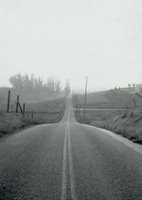

"On the old highway maps of America, the main routes were red and the back roads blue. Now even the colors are changing. But in those brevities just before dawn and a little after dusk – times neither day nor night – the old roads return to the sky some of its color. Then, in truth, they carry a mysterious cast of blue, and it’s that time when the pull of the blue highways is strongest, when the open road is beckoning, a strangeness, a place where a man can lose himself."
Heat-Moon takes off on his voyage after losing his job as an English instructor at a Missouri college due to dropping enrollment and learning that the wife (whom he'd been separated from for nine months) had a new friend named "Rick or Dick or Chick. Something like that".
So, with heavy heart he takes off in a 1975 half-ton Ford Econoline he dubbs "Ghost Dancing":
Now, while the thought of driving along America's small highways, and back country routes may sound really nice (romantic, even), in reality, this was obviously a daunting endeavor. Many times as I read, I couldn't help but be impressed at what a ballsy, gutsy thing he was doing. There are points when he is driving on single lane, gravel roads up in the Rocky Mountains. He drives through isolated desert highways in Nevada and Arizona, and empty, remote areas in the Dakotas. Keep in mind, 1978 is long before cell phones, OnStar, or even GPS devices. There would have been no ATMs, not that it would've mattered: "In my billfold were four gasoline cars and twenty-six dollars. Hidden under the dash were the remnants of my savings account: $428."
He takes with him:
"1 sleeping bag and blanket;
1 Coleman cooler;
1 Rubbermaid basin and plastic gallon jug (the sink);
1 Sears, Roebuck portable toilet;
1 Optimus 8R white gas cook stove (hardly bigger than a can of beans);
1 knapsack of utensils, a pot, a skillet;
1 U.S. Navy seabag of clothes;
1 tool kit;
1 satchel of notebooks, pens, road atlas, and a microcassette recorder;
2 Nikon F2 35mm cameras and five lenses;
2 vade mecums: Whitman's Leaves of Grass and Neihardt's Black Elk Speaks."
Nacogdoches manages to earn a mention in the "South By Southwest" section as he makes his way across Texas on Hwy. 21.
Along the way, Heat-Moon engages the strangers he meets in the small towns off of blue highways in conversation. Even in 1978, there's a sense of something having been lost in this country--values, mores, grit...something dying, surely dead now, twenty-seven years down the road. If circumstances prevent you from climbing into your Ghost Dancing and journeying forth on America's rapidly decreasing small, two-lane, blue highways, perhaps this book can provide the next best thing, and give you a little mind expansion.
If circumstances prevent you from climbing into your Ghost Dancing and journeying forth on America's rapidly decreasing small, two-lane, blue highways, perhaps this book can provide the next best thing, and give you a little mind expansion.
No comments:
Post a Comment